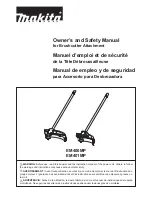
4
Starting motor
Wear the personal equipments before starting the motor.
•
Start the engine at least 3 meters (10 feet) away from the fueling
•
spot.
Before starting the motor, make sure that there is no person or
•
animal in the work area.
When starting the engine or inserting a battery cartridge, keep
•
the cutting tool clear of your body and other object, including
the ground. It may rotate when starting and may cause injury or
damage to the equipment and/or property.
Place the equipment on firm ground. Maintain good balance and
•
secure footing.
When pulling the starter knob, hold the power unit firmly against
•
the ground by your left hand. Never step on the drive shaft of the
power unit.
Follow the instruction manual of the power unit for starting the
•
motor.
If the cutting tool rotates at idle, stop the engine and adjust the
•
idle speed down.
Operation
In the event of an emergency, switch off the motor immediately.
•
If you feel any unusual condition (e.g. noise, vibration) during
•
operation, switch off the motor. Do not use the equipment until
the cause is recognized and solved.
The cutting tool continues to rotate for a short period after
•
releasing the throttle trigger or switch off the motor. Don’t rush to
contact the cutting tool.
With the engine running only at idle, attach the shoulder harness.
•
During operation, use the shoulder harness. Keep the equipment
•
on your right side firmly.
Hold the front handle with the left hand and the rear grip with the
•
right hand, no matter you are right-hander or left-hander. Wrap
your finger and thumbs around the handles.
Never attempt to operate the equipment with one hand. Loss of
•
control may result in serious or fatal injury. To reduce the risk of
injury, keep your hands and feet away from the cutting tool.
Do not overreach. Keep proper footing and balance at all times.
•
Watch for hidden obstacles such as tree stumps, roots and
ditches to avoid stumbling.
Never work on a ladder or tree to avoid loss of control.
•
If the equipment gets heavy impact or fall, check the condition
•
before continuing work. Check the fuel system for fuel leakage
and the controls and safety devices for malfunction. If there is
any damage or doubt, ask Makita authorized service center for
the inspection and repair.
Do not touch the gear case. The gear case becomes hot during
•
operation.
Take a rest to prevent loss of control caused by fatigue. We
•
recommend taking a 10 to 20-minute rest every hour.
When you leave the equipment, even if it is a short time, always
•
switch off the engine or remove the battery cartridge. The
equipment unattended with the engine running may be used by
unauthorized person and cause serious accident.
Follow the instruction manual of the power unit for proper use of
•
the control lever and switch.
During or after operation, do not put the hot equipment onto dry
•
grass or combustible materials.
If grass or branches get caught between the cutting tool and
•
guard, always stop the motor and remove the spark plug cap or
the battery cartridge before cleaning. Otherwise unintentional
blade rotation may cause serious injury.
If the cutting tool hits stones or other hard objects, immediately
•
switch off the motor and inspect the cutting tool.
Check the cutting tool frequently during operation for cracks or
•
damages. Before the inspection, switch off the motor and wait
until the cutting tool stops completely. Replace damaged cutting
tool immediately, even if it has only superficial cracks.
Never cut above waist height.
•
Before starting the cutting operation, wait until the cutting tool
•
reaches a constant speed after pulling the trigger.
When using metal blades, swing the tool evenly in half-circle from
•
right to left, like using a scythe.
Cutting tools
Use an applicable cutting tool for the job in hand.
•
Nylon cutting heads (string trimmer heads) are suitable for
trimming lawn grass.
Metal blades are suitable for cutting weeds, high grasses,
bushes, shrubs, underwood, thicket, and the like.
Never use other blades including metal multi-piece pivoting
chains and flail blades. It may result in serious injury.
Always use the cutting tool guard properly suited for the cutting
•
tool used.
When using metal blades, avoid “kickback” and always prepare
•
for an accidental kickback. See the section “Kickback.”
Kickback (Blade thrust)
Kickback (blade thrust) is a sudden reaction to a caught or bound
•
cutting blade. Once it occurs, the equipment is thrown sideway or
toward the operator at great force and it may cause serious injury.
Kickback occurs particularly when applying the blade segment
•
between 12 and 2 o’clock to solids, bushes and trees with 3 cm
or larger diameter.





































